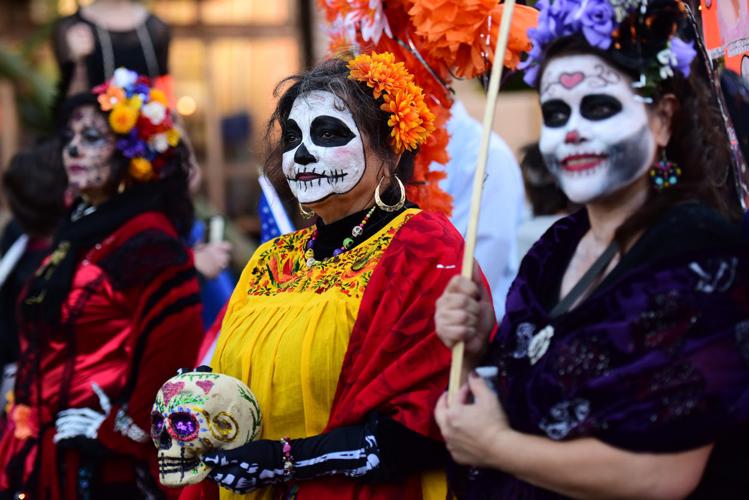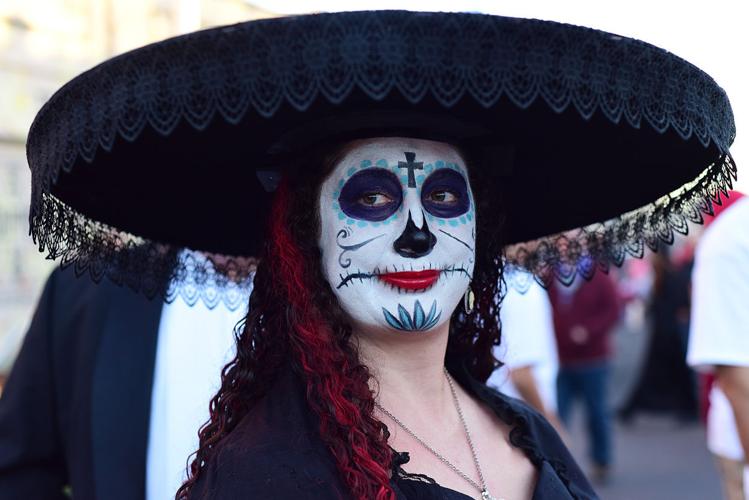The articles and proclamations abound:
The Mexican holiday Día de los Muertos has been “Columbused” by white people who just want to have a good time.
They costume themselves in iconic sugar skull makeup, thoughtlessly claiming the culture of the oppressed.
They drink, they insult the holiday, they take it for our own.
There is no doubt that Tucson’s 26-year-old All Souls’ Procession has parallels to the original Aztec celebration. But is Tucson’s homegrown holiday different than, say, the San Francisco hipster fest that takes place in the gentrified Mission District every year?
To find out what locals thought, I reached out to students, academics, activists, All Souls’ Procession attendants and others, asking them what they felt about appropriation, and how to march in a culturally responsible way.
The most passionate responses were from those who are personally connected to the celebration.
• On the similarities and differences between All Souls’ Procession and the Mexican holiday Día de los Muertos:
“... All Souls’ Procession certainly borrows the aesthetic of Día de los Muertos, at least as it is celebrated in some parts of Mexico, and follows the pattern of having a separate time dedicated to children and another for everyone. ... Other elements of the All Souls’ Procession are nontraditional to the Mexican holiday. My understanding is that in many parts of Mexico, Día de los Muertos is celebrated quietly with the construction of altars at home or wherever loved ones are buried ... The urn, which is fairly central to the All Souls’ Procession, is also nontraditional to the Mexican celebration ...” — Misty Ring-Ramirez, PhD candidate in sociology
“The procession is a gathering of many cultures, many beliefs and has never held its roots with Día de los Muertos. But naturally, Tucson resides in a largely Latinx population. ... It is normal that a majority of the participants would identify with the culture of the Day of the Dead celebrated in Mexico as part of their Mexican, Catholic, or Aztec roots. And that is OK.” — Eva Pena, All Souls’ Procession Urn Spirit Group volunteer
• Is All Souls’ cultural appropriation?
“It is akin to or the cultural equivalent of gentrification.” — Roberto Rodríguez, associate professor in the Mexican American and Raza Studies Department at the University of Arizona
“We live in a city that has deep and intimate roots in Mexico. To me, it feels natural that celebrations in Tucson reflect the diversity of the city itself. ... The spirit of the procession and (most of) those who participate in it, seems very different from wearing a culture as a costume, which in my opinion is unequivocally negative. But, as a non-Hispanic person, it is not my place to define what is and is not offensive cultural appropriation.” — Ring-Ramirez
• On personal relationships with Día de los Muertos:
“I am a native Mexican-American Tucsonan and a former Catholic. Our family never celebrated the Day of the Dead. … Day of the Dead back in my day was something that was celebrated in Southern Mexico, and was considered a pagan ritual. The procession today is an extension of Halloween, with a central theme of skeletons or painted skulls, and very much more paganistic.” — Alfred Quiroz, painter, professor at the University of Arizona School of Art
“As a Hispanic child growing up, I didn’t even understand this. I had never heard of such a celebration in my own culture. It wasn’t until a coworker of mine brought in pictures of him participating at an All Souls’ Procession back in 2003 that I became knowledgeable of the history behind it. Today as a parent, I am able to teach my children the meaning behind Día de los Muertos, and All Souls’ Procession.” — Michelle Beltran, All Souls’ Procession attendant
“Honestly, since I’m Mexican but was raised by white Mormon parents, it makes me happy to participate in All Souls’. It makes me feel more connected to being Mexican, even though I wasn’t raised knowing my traditional background. Anyway, I love that Tucson invites the city to participate, and I feel like the city is pretty respectful of the tradition.” — Rikenna Lines, Chicago resident traveling to Tucson for the procession
• Does All Souls’ address something that’s lacking in American culture?
“The procession mimics the doom and gloom feeling that is prevalent in this country since the days of 9/11. The cultural obsession with death, vampires and, of course, zombies are all inherent in this celebrative event for those that have departed. It has become a big art party. Which I think is positive.” — Quiroz
“So many people have become immune to loss and death. Some do not know how to express loss and grief. My heart opened up after my first experience with All Souls’. I have since introduced family and friends to the event and we work together on our displays.” — Anna M. Mendoza, native Tucsonan
“We spend so much time working, taking care of duties, on the go, planning, we can forget to take time to grieve, to express that grief, share it openly and sometimes even just feel the grief. I believe All Souls’ Procession gives space for all of that.” — Davina Araiza, All Souls’ Procession attendant
“It is all too often frowned upon for people to publicly grieve. It is something that society expects to be a private process. ... There are always those conversations when someone has to say, in a whisper, “and then he died,” like it’s something dirty, something feared. The procession provides a way for those who need it, to have a creative or artistic release as part of their healing and grieving.” — Pena
• How can a white person celebrate All Souls’ respectfully?
“Not making it a Halloween celebration. Two different events.” — Terri Lynn-Cross, market analyst with the Arizona Daily Star
“The All Souls’ Procession could be seen as a giant funeral march, and people should act accordingly to that notion. It isn’t a party, it is not Halloween, but it is a celebration and it is easy to confuse the two. Celebrations of spirit are always sacred, so they should be treated with the most respect. A party is where you go to imbibe and socialize.” — Adam Cooper-Terán, director of the Ancestors Project at All Souls’ Procession
“Everyone has their own way to celebrate. My father passed away earlier this year, and his birthday is coming up. Being with my family and carrying out our own traditions, and passing those on to my kids is the best way I know to honor his memory.” — Regina Romero, Tucson City Council member
• What about wearing sugar skulls on our faces?
“I would never tell anyone not to wear sugar skull makeup. Every year we have various artists, some of them Hispanic and Latino, who paint the faces of the public who want to look like calaveras. It isn’t something to deny the public because we are an inclusive event.” — Cooper-Terán
“I believe as long as love and respect are your first thoughts that go into your dress or art, that’s all that matters.” — Miguel Beltran, procession attendant
“For some people, wearing a calavera (a.k.a. “sugar skull”) makeup may feel sacred. For others perhaps a drink to honor the dead may feel sacred. I think the key word here is respect. To participate in the All Souls’ Procession responsibly, we all need to respect each other and hold the space for each other to practice what we fell is right and sacred for us.” — Susan K. Tiss, Tucson native and All Souls’ Procession participant and volunteer
“… I think the key is to respect other people’s safety and right to participate in a meaningful way. Any behavior that is obnoxious, dangerous, or crude can ruin an important experience for others — especially children and families with children — and is irresponsible.” — Misty Ring-Ramirez
“I don’t mind those who indulge in adult beverages or celebrate how they see fit. I do think that if you choose to celebrate by drinking alcohol, just be mindful of your limits and stay respectful.” — Michelle Beltran
• Does All Souls’ have the power to unite the community?
“It creates a spectacle ... with drunks littering the route all along the way.” — Roberto Rodriguez
“The procession is a unifying element for the city. Hundreds of individuals dressed in black donning face-paint show up from the youngest to the oldest for the procession of the celebration of the dearly departed. It is also a good place to take visiting relatives and tourists.” — Quiroz






